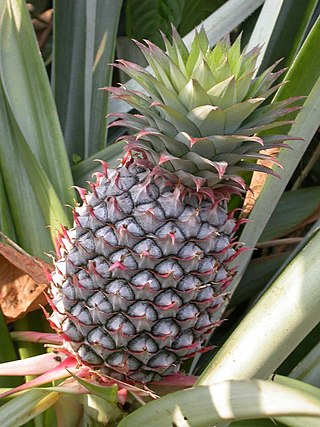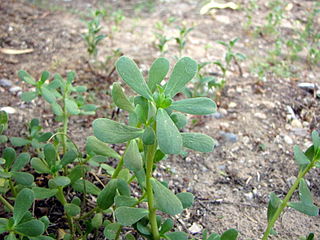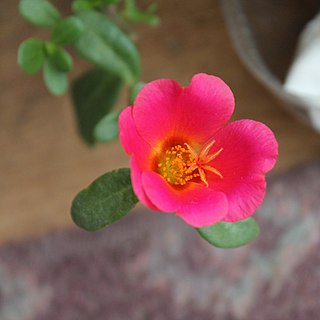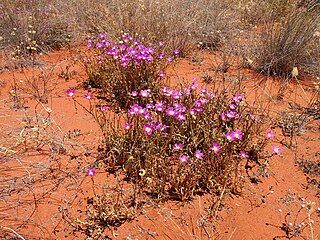
Crassulacean acid metabolism, also known as CAM photosynthesis, is a carbon fixation pathway that evolved in some plants as an adaptation to arid conditions that allows a plant to photosynthesize during the day, but only exchange gases at night. In a plant using full CAM, the stomata in the leaves remain shut during the day to reduce evapotranspiration, but they open at night to collect carbon dioxide and allow it to diffuse into the mesophyll cells. The CO2 is stored as four-carbon malic acid in vacuoles at night, and then in the daytime, the malate is transported to chloroplasts where it is converted back to CO2, which is then used during photosynthesis. The pre-collected CO2 is concentrated around the enzyme RuBisCO, increasing photosynthetic efficiency. This mechanism of acid metabolism was first discovered in plants of the family Crassulaceae.

Portulaca oleracea is an annual succulent in the family Portulacaceae.

Portulaca is a genus of flowering plants in the family Portulacaceae, and is the type genus of the family. With over 100 species, it is found in the tropics and warm temperate regions. Portulacas are also known as the purslanes.

The Portulacaceae are a family of flowering plants, comprising 115 species in a single genus Portulaca. Formerly some 20 genera with about 500 species, were placed there, but it is now restricted to encompass only one genus, the other genera being placed elsewhere. The family has been recognised by most taxonomists, and is also known as the purslane family. It has a cosmopolitan distribution, with the highest diversity in semiarid regions of the Southern Hemisphere in Africa, Australia, and South America, but with a few species also extending north into Arctic regions. The family is very similar to the Caryophyllaceae, differing in the calyx, which has only two sepals.
Purslane is a common name for several mostly unrelated plants with edible leaves and may refer to:

Portulaca grandiflora is a succulent flowering plant in the purslane family Portulacaceae, native to southern Brazil, Argentina, and Uruguay and often cultivated in gardens. It has many common names, including rose moss, eleven o'clock, Mexican rose, moss rose, sun rose, table rose, rock rose, and moss-rose purslane. Despite these names and the superficial resemblance of some cultivars' flowers to roses, it is not a true rose, nor even a part of the rose family or rosid group; rather, it is much more closely related to carnations and cacti.

Talinum paniculatum is a succulent subshrub in the family Talinaceae that is native to much of North and South America, and the Caribbean countries. It is commonly known as fameflower, Jewels-of-Opar, or pink baby's-breath.

Sesuvium portulacastrum is a sprawling perennial herb in the family Aizoaceae that grows in coastal and mangrove areas throughout much of the world. It grows in sandy clay, coastal limestone and sandstone, tidal flats and salt marshes, throughout much of the world. It is native to Africa, Asia, Australia, Hawai`i, North America and South America, and has naturalised in many places where it is not indigenous.

Parakeelya balonensis is a species of succulent plant native to arid and semi-arid regions of Australia. Common names for the plant include parakeelya, broad-leaf parakeelya, broad-leaved parakeelya and Balonne parakeelya. Parakeelya derives from one of the many Aboriginal Australian names for the plant. The scientific name for the species comes from the Balonne River in Queensland, where the first specimen was found. Calandrinia, its former genus, is named for Jean Louis Calandrini, a 19th-century Genevan professor and botanical author, P. balonensis is marketed as a garden plant under the name Calandrinia ‘Mystique’.

In botany, succulent plants, also known as succulents, are plants with parts that are thickened, fleshy, and engorged, usually to retain water in arid climates or soil conditions. The word succulent comes from the Latin word sucus, meaning "juice" or "sap".

Portulaca pilosa is a species of flowering succulent plant in the purslane family, Portulacaceae, that is native to the Americas. Its common names include pink purslane, kiss-me-quick and hairy pigweed. Its range extends from the southern United States and the Caribbean as far as Brazil. It is a succulent plant with linear leaves and pink flowers.

Portulaca bicolor is a succulent species of the family Portulacaceae with cylindrical leaves and red stems. Flowering all year the plant is common to coastal regions of Australia.
Peter Grubb was a British zoologist. He often collaborated with Colin Groves and described several new mammal taxa including Felis margarita harrisoni, the Bornean yellow muntjac, the Nigerian white-throated guenon, Cephalophus nigrifrons hypoxanthus, the white-legged duiker, Cephalophus silvicultor curticeps, Cephalophus weynsi lestradei, the Kashmir musk deer, and the Niger Delta red colobus.

Portulaca molokiniensis, known also as 'ihi, is a succulent plant endemic to Hawaii. This plant is federally listed as an endangered species. It has small yellow flowers and when grown from seed may produce a caudex. This plant is easy to propagate.

Portulaca oleracea subsp. sativa also known as golden purslane is one of few subspecies of Portulaca oleracea.

Portulaca lutea, the native yellow purslane, is a species of Portulaca that is indigenous to all of the main islands of Hawaii except for Kaua'i and is widespread throughout the Pacific Islands.

Portulaca umbraticola, also known as the wingpod purslane, is an annual or short-lived perennial succulent in the genus of flowering plants Portulaca.

"Democracy Manifest" is an October 1991 Australian news segment video by reporter Chris Reason. The Guardian, in 2019, called it "perhaps the pre-eminent Australian meme of the past 10 years". YouTube has several postings of the video with more than a million views each.

Portulaca filsonii is a plant in the Portulacaceae family, endemic to central Australia in the Northern Territory.
Portulaca monanthoides is a species of flowering plant in the family Portulacaceae. It is a succulent subshrub endemic to western Socotra island in Yemen. It occurs in small depressions on limestone slabs on an exposed ridge above Jebel Shu'ub.

















